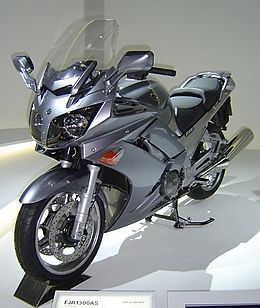Yamaha FJR1300AE
 |
|
| Manufacturer | Yamaha |
|---|---|
| Production | since 2001 |
| Predecessor | FJ1200 |
| Class | Sport Touring |
| Engine | 1,298 cc transverse inline-4, liquid-cooled, DOHC, four valves per cylinder, electronic fuel injection |
| Bore / stroke | 79.0 mm × 66.2 mm (3.11 in × 2.61 in) |
| Compression ratio | 10.8:1 |
| Power | 105.5 kW (141.5 hp) @ 8,000 rpm |
| Torque | 134.4 N·m (99.1 lbf·ft) @ 7,000 rpm |
| Transmission | 5-speed manual (6-speed from 2016), Shaft drive AE/AS: Electronic clutch |
| Suspension | Front: 48 mm telescopic fork, 137 mm wheel travel Rear: Single shock, link type, 122 mm wheel travel |
| Brakes | Front: Dual 320 mm disc four-piston calipers Rear: Single 283 mm disc two-piston caliper ABS standard (optional before 2006) |
| Tires | Front: 120/70ZR17 Rear: 180/55ZR17 |
| Wheelbase | 1,545 mm (60.8 in) |
| Dimensions |
L: 2,230 mm (88 in) W: 750 mm (30 in) H: 1,450 mm (57 in) |
| Seat height | 805 mm (31.7 in) |
| Weight | 264 kg (582 lb) AE/AS: 269 kg (593 lb) (dry) 291 kg (642 lb) AE/AS: 295 kg (650 lb) (wet) |
| Fuel capacity | 25 L (5.5 imp gal; 6.6 US gal) |
The Yamaha FJR1300A and FJR1300AE/AS are sport touring motorcycles made by Yamaha Motor Company. Both models have a 1,298 cc inline-four engine. The AE/AS model has an electronically controlled clutch and gear shifting system called YCC-S. The clutch and transmissions of the AE/AS models are identical to that of the standard FJR model.
The FJR1300 was introduced to Europe in 2001, before arriving in North America in 2002, with the 2003 model year designation, and offered in a non-ABS version only. The 2003 model garnered several awards in the Sport Touring category from various magazines.
The 2004 North American models included both a non-ABS version with traditional blue anodized brake calipers and a new ABS version with silver calipers. Other refinements included an upgrade to the suspension rates, 320 mm front brake discs (was 298 mm), and a fairing pocket for small items.
The 2005, North American model year remained structurally unchanged with a non-ABS and ABS model.
In 2006, the U.S. and rest of the world model years synchronized with the introduction of what has become known as the 'Gen-II' version of the machine. The design changes included significant trailing arm changes, revised final drive ratio, a curved radiator exhibiting a larger surface area, instrumentation changes, an upgraded alternator and significant attention to airflow changes to deal with reported heat issues in previous years. Yamaha added adjustable vents to the FJR1300, allowing the rider to direct air closer to or away from the body. Starting with the 2006 models Anti-Lock Brakes (ABS) and a linked braking scheme Yamaha calls 'Unified Braking System' (UBS) became standard.
Also, the FJR1300AS model (FJR1300AE in U.S.A. and Canada) was introduced which had a semi-automatic transmission. The AE variant was discontinued for 2010, although the AS model continued to be sold in markets outside of the USA and Canada.
For 2007, some very minor changes were made to the ECU to deal with potential issues related to altitude changes under certain circumstances. In 2008 changes were made to throttle 'feel', to improve low speed on/off throttle transitions. As well Yamaha changed suppliers for the ABS system. Further refinements in the throttle control were introduced with the 2009 model.
For 2012 the previously optional heated hand grips became standard.
...
Wikipedia
